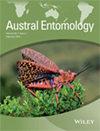SWARMING BEHAVIOUR OF THE LESSER HOUSE FLY, FANNIA CANICULARIS, IN BRISBANE
引用次数: 2
Abstract
Studies of the lesser house fly, Fannia canicularis, in Brisbane, Queensland showed that males swarmed at closed in sites, such as under and inside houses. Flies preferred the centre of an area, though variations in light intensity and the presence of objects in the swarming area modified this behaviour. When temperatures remained above 15°C, swarming occurred from about sunrise to sunset, though on days with a maximum above 25 °C, few swarmed near midday. Males flew for long periods in semi‐rectangular circuits, though at high fly populations such circuits were often not completed as flies constantly chased each other. Resting males also chased flies or objects that moved rapidly within two metres of them; slow moving objects were ignored. Although F. canicularis forms swarms like smaller Diptera, this chasing of other males is characteristic of the waiting station and territorial defense of larger species. On coming to land, males preferentially faced and alighted head upwards; most then turned to rest head downwards, thus accounting for the head downwards posture of resting males noted here and elsewhere.在布里斯班,小家蝇的成群行为
在昆士兰的布里斯班,对一种较小的家蝇进行的研究表明,雄性家蝇聚集在封闭的地方,比如房子的下面和里面。苍蝇更喜欢在一个区域的中心,尽管光照强度的变化和群体区域中物体的存在会改变这种行为。当温度保持在15°C以上时,蜂群发生在日出到日落之间,但在最高温度超过25°C的日子里,中午附近很少有蜂群。雄性在半矩形的循环中飞行很长一段时间,尽管在高蝇群中,这种循环通常不会完成,因为苍蝇经常互相追逐。休息的雄性也会追逐苍蝇或两米内快速移动的物体;缓慢移动的物体被忽略。尽管像小型双翅目昆虫一样,canicularis形成了一群,但这种追逐其他雄性的行为是大型物种等待和领土防御的特征。雄性在上岸时,倾向于脸朝上,头朝上;然后大多数人转向头朝下休息,从而解释了这里和其他地方注意到的头部朝下休息的男性姿势。
本文章由计算机程序翻译,如有差异,请以英文原文为准。
求助全文
约1分钟内获得全文
求助全文

 求助内容:
求助内容: 应助结果提醒方式:
应助结果提醒方式:


